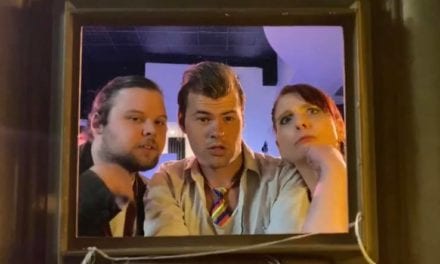SALT LAKE CITY – The description of Saintmakers, written and directed by Riley Trepanier and produced by Wasatch Theatre Company, peaked my interest. The play involves a man dying of Mad Cow Disease, disturbed by hallucinations of controversial figures from the French Revolution, one of whom, having been murdered in his bathtub, is confined to a bathtub for the duration of the production. I have a soft-spot for absurdism—and this production is honestly fairly light on the absurdism. But they had me at on-stage bathtub confinement. I love seeing creative new works and local playwrights featured in our community.
The production is performed at the intimate Regent Street Blackbox behind the Eccles mainstage theatre. I was intrigued by a poster situated in the second story lobby featuring a timeline of the involvement of Maximilien Robespierre (played by Marc Reading) and Jean-Paul Marat (played by Stephen Moore) in the French revolution. This timeline was juxtaposed above a timeline of the progression of symptoms Mad Cow Disease (Variant Creutzfelt-Jakob disease)—which includes hallucinations. I truly appreciate when a production takes time to offer contextual elements to audience members that allow for a deeper dive into the world of the play. Walking into the performance space, the audience is greeted with religious organ music, with some Bond movie themes adapted for organ (sound design by Sam Clawson) and a stage with a bed at one end and a bathtub at the other, medicine and papers are strewn haphazardly about the space (prop support by Miranda and Josh Bauer).
I am likewise appreciative of a good director’s note, and even moreso if there is also commentary from a dramaturg—the Saintmakers digital program offers both. Trepanier describes how the play was influenced by his experiences caring for a dying relative and subsequently working with dying patients and their families as a hospital chaplain. I expect most of us have had some experience with the death of a loved one, a universal, if often under-discussed theme of life. I appreciate that Trepanier fearlessly addresses the taboo subject with grace, humor and wisdom. His director’s note describes grief as “holy” and pain as “patient”. He leaves an invitation to his audiences to consider their priorities, and issues a blessing that they “may find those who will choose you, every time.” Dramaturg Braxton Church likewise provides poignant insight into the script, and its basis in the well-known story of Mary and Martha in the Bible.
Trepanier’s directing and writing is somewhat fluid, with one scene moving into the next with efficiency, and overlapping and interweaving dialogue between the real and imagined characters. It felt like there was still room for improvement in that fluidity—scene transitions could have been written even tighter, with fewer lighting swaps to indicate the passing of time, and perhaps more creative theatrical convention to move from one scene to the next. Similarly though mostly successful, the interwoven dialogue could also have been tighter—there still felt like some moments when the real characters seemed to be waiting unnaturally for the dialogue of the hallucinations to complete. I would have liked to see greater overlapping and interweaving dialogue. That aside, Trepanier’s dialogue is in equal measure, clever, funny and poignant.

Saintmakers played at the Regent Street Blackbox Theatre through April 27.
The show is well cast—the three siblings seem to have good, if somewhat dysfunctional, family chemistry. Danny, played by Kobe Black, serves as a foundation, even despite his illness, holding together the polar opposites in his sisters, Niamh (played by Kristina Shearer), and Piper (played by Chelsea Hickman). Black’s performance is heartfelt. Playing a man dying of debilitating illness in his prime is challenging for any actor who is likely personally unacquainted with such experience, and there were moments that this showed in somewhat contrived affectations that read like an actor “acting sick”, despite the sincerity of the performance.
Admittedly, I have no personal experience with Mad Cow Disease either, but the poster in the lobby provides some familiarity with the symptoms. Hickman’s character development as Piper was effective. Her portrayal of Piper’s debilitating anxiety while trying to care for her dying brother was often heart wrenching. I was particularly moved by Shearer’s portrayal Niamh and her character arc. Her performance at the final climax, wherein she sacrifices her own skepticism to her great love for Danny (with impeccable comic timing) is outstanding. Moore and Reading compliment the sibling Trio capably, however I did find Reading’s Robespierre a bit stiff initially and difficult to understand at times in several of his quickly uttered lines.
Nonetheless the character is somewhat redeemed by the end as realization of his own sister’s devotion arises, within Danny’s hallucination, as Danny recognizes the same in his own sisters. Moore’s Marat, confined to the bathtub did not disappoint. I find that such restraints can provide a boundary that the actor can use to effectively play against. The bathtub does that for Moore, and his Marat was able to add quite a bit of necessary humor to the heavy subjects of the play. I also appreciated his character arc, that began as a humorous, if lascivious towel-clad hallucination, and without leaving the tub, developed into a demanding, petty charlatan.
Costuming by Laney Lillywhite is generally well done. Robespierre’s red and gold suit is gorgeous, the sisters’ clothing helps to define their distinct characters quite well, and Marat’s towel is comically, just a bit too small for comfort. Though this is likely by design for the humor of it, but the number of times he had to turn upstage to re-wrap and adjust his towel leaned into distraction—something that could have been easily rectified with a little bit of costuming magic involving a more secure closure.
There are a few really striking tableaus, first by Marat and Robespierre as they strike a regal pose at the tub, and later, as the sisters pray beside the bed where Danny lies restrained and convulsing. And finally at the climax with Niamh standing on the chair at the desk, haloed in warm light (by Amber Knaras), as she embraces her role as the new pope Benedict.
At the end of the show, Trepanier entered the house with Church and they invited the audience to stay for a discussion. I’m used to talk-backs where the audience is invited to ask questions of the company. Church however began the discussion by asking the audience specific questions about the production—creating an awkward feeling of being in a Sunday school class where the teacher poses a question none of the 25 people in attendance was prepared to answer (anyone?). Although it might have been less awkward to have started with Church asking the company a couple of questions, then turning to the audience for any additional questions, this audience responded graciously with thoughtful responses. The awkwardness dissipated somewhat and a useful discussion ensued.
The show is a swift 70 minutes without intermission which felt just about right for such a production. It is a thought-provoking evening of well-done theatre. Unfortunately this was a late requested review with a brief run, and the production will have closed by the time this is published. Nonetheless, I highly recommend watching for upcoming Wasatch Theatre Company productions as everything I’ve seen this company produce has been worthwhile.

These reviews are made possible by a grant from the Salt Lake County Zoo, Arts, and Parks program.





